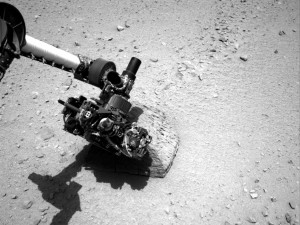The Curiosity rover made its first contact with Martian rock this past weekend. It shot lasers at a rock named “Jake Matijevic” in order to analyze its chemical composition. This is Curiosity’s first scientific experiment. Results pending… From nasa.gov:
After a short drive the preceding day to get within arm’s reach of the football-size rock, Curiosity put its Alpha Particle X-Ray Spectrometer (APXS) instrument in contact with the rock during the rover’s 46th Martian day, or sol. The APXS is on a turret at the end of the rover’s 7-foot (2.1-meter) arm. The Mars Hand Lens Imager (MAHLI), on the same turret, was used for close-up inspection of the rock. Both instruments were also used on Jake Matijevic on Sol 47 (Sept. 23).
The Chemistry and Camera (ChemCam) instrument, which shoots laser pulses at a target from the top of Curiosity’s mast, also assessed what chemical elements are in the rock Jake Matijevic. Using both APXS and ChemCam on this rock provides a cross calibration of the two instruments.
More details at Scientific American and nasa.gov.

